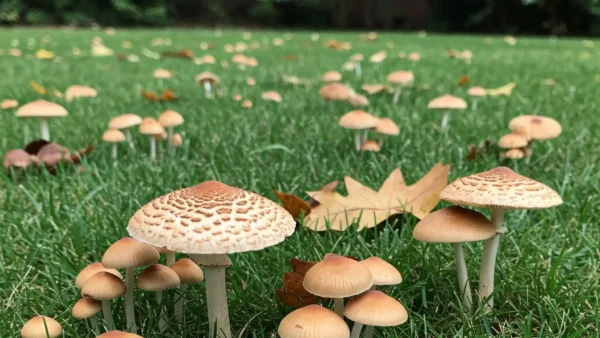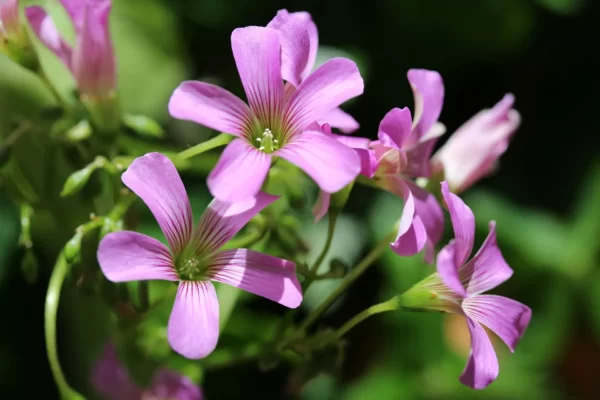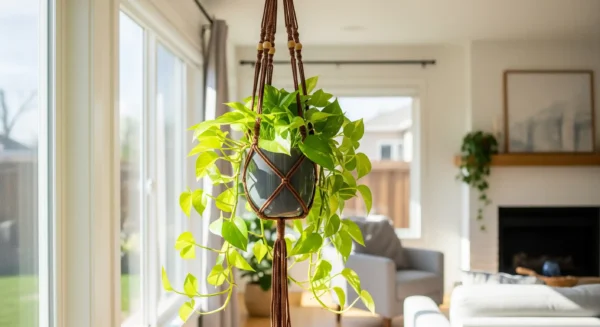Enjoy Your Patio in Peace: The Surprising Plants That Tell Bees to Buzz
Everybody who owns a patio, deck, or balcony dreams of this idyllic scene: a warm, sunny afternoon, a refreshing beverage, and a soft breeze that carries the delightful aroma of your garden. Everything is wonderful—until a very persistent, buzzing guest believes your lemonade is the most intriguing flower in the area. A low-grade worry that involves swatting and flinching suddenly fills that serene moment. And that raises a complex emotion, doesn’t it? We love our bees since we are gardeners and nature enthusiasts. We want them to flourish because we know they are the industrious, vital workers of our environment, pollinating a large amount of the food we eat. But occasionally, especially if we have curious kids, pets, or family members with allergies, we also want to be able to eat outside without worrying about getting stung. Our love of the natural world and our need for security and comfort seem to be at odds with one another.
This very conundrum is what prompts so many of us to pose that important query in an effort to establish harmony. I know you’re searching for a responsible, workable solution, so let’s get started. Which plants don’t attract bees? Plants with strong, strong aromas that bees, with their extremely sensitive antennae, find overwhelming and unpleasant are usually the most efficient and dependable for gently discouraging bees. Think of fragrant grasses and plants such as real citronella grass, wormwood, peppermint, and eucalyptus. Similar to loud static on a radio channel, their powerful aromas serve as a natural “no-entry” sign, confusing the delicate floral scents that bees are actually attempting to follow.
Here’s the trick that turns this list of plants into a very successful plan: it’s not just about what you plant, but also about how and where you employ them. It won’t make much difference if you just spread these plants over your yard. Strategic utilization of these fragrant powerhouses to create limited, targeted, bee-free zones is the true art. Reclaiming a tranquil area for ourselves while honoring our essential pollinators is a delicate balance. The goal of this article is to help you strike the ideal balance. In-depth discussions of the best plants, the science underlying their effectiveness, and—above all—how to use them sensibly to create a lovely, buzz-free haven for you and your family to enjoy, while leaving the remainder of your garden as a warm haven for our cherished bees.
A Guide to Bee-Deterring Plants for Gardeners
Now, let’s move on to the exciting part: the actual plants! These are the heavy hitters that have worked well when you want to build an aromatic barrier. Their strong aroma, which is pleasing to humans but perplexing and overwhelming to bees, is the secret to all of them.
The Mint Family (Mentha piperita) and peppermint
Peppermint is the star of bee deterrent, if you will. The strong, sharp, minty scent that we adore in gum and tea is just too strong for a bee’s sensitive senses. They usually steer clear of it at all costs. It is also a great all-around option for a quiet patio because wasps and hornets are equally repulsed by the potent aroma.
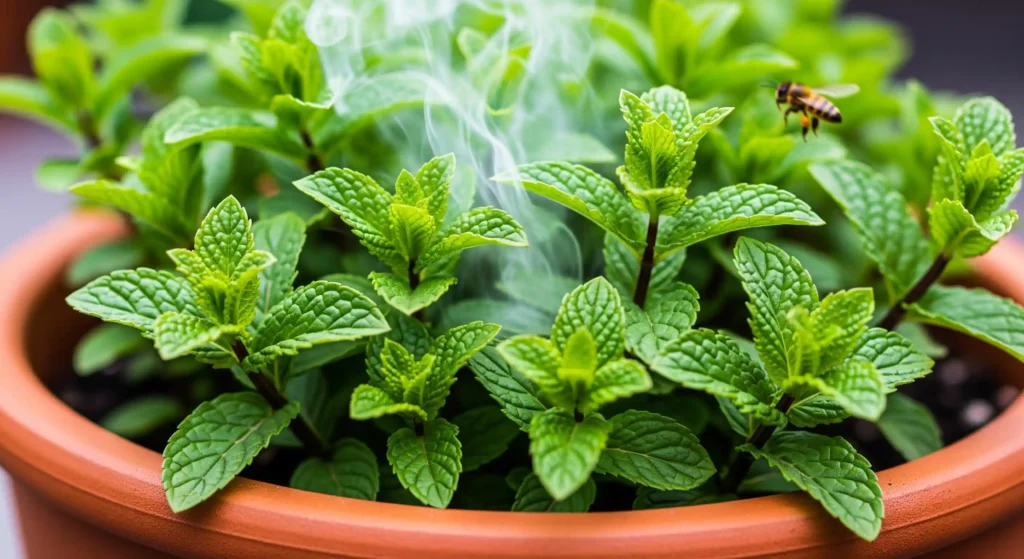
- Why it works: The lovely, flowery scents that bees utilize to find food sources are obscured by the overpowering menthol scent.
- Growing mint: I can’t emphasize this enough: grow mint in a container! If you allow it, this extremely aggressive plant will take over your entire garden bed in a single season by sending forth runners underground. You can keep it contained and provide that bee-repelling aroma exactly where you need it with a simple pot on your deck. It is quite hardy and doesn’t care for the type of soil. Crush a leaf between your fingers occasionally to produce a new aroma wave for an added boost. Strong mints like spearmint also work well.
Artemisia absinthium, or wormwood
This intriguing plant is well-known for both its relationship with the powerful drink absinthe and its lovely, silvery-gray foliage. Its strong, herbaceous perfume, which is extremely unpleasant to bees and many other insects, is as strong as its history. In addition, its silvery leaves create a striking visual contrast with other plants’ green foliage.
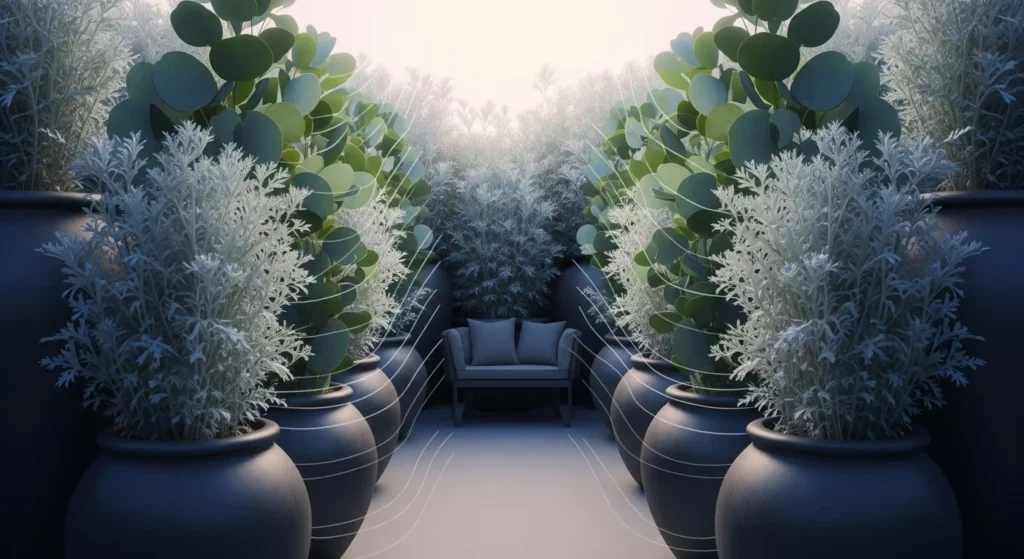
- Why it works: Wormwood gets its bitter scent from a substance called absinthin. It has been used for ages as an excellent natural insect repellant.
- Growing instructions: Wormwood is a hardy perennial that does best in full sun and near-poor, well-drained soil. It’s better to plant it on the outside or border of a seating area rather than in the center because it can grow very huge. To manage its size, it can also be cultivated in a large, deep pot. Be advised that wormwood can cause allelopathy, which is the inhibition of the growth of certain plants in its immediate vicinity.
Cymbopogon citratus, or lemongrass
Lemongrass, a close relative of citronella grass, has a delightfully fresh, lemony aroma that is delightful in the kitchen and has a similar bee-bothering effect.
- Why it works: Citral, a crucial aromatic molecule found in it, confuses insects’ sensory receptors similarly to citronella.
- How to cultivate it: In most U.S. regions, lemongrass grows best as an annual in a pot. Like citronella grass, it is a delicate perennial. It adores the sun and heat. The stalks are a multipurpose patio powerhouse that can be used in stir-fries, soups, and drinks.
Basil, especially the stronger types
Common sweet basil blossoms are a favorite of many bees, but some types with a stronger, more overpowering scent may discourage them. Bees searching for more straightforward floral notes may be confused by the spicy, clove-like aroma of cinnamon basil or Thai basil.
- Why it works: These particular basil kinds’ potent, spicy aromas, which are high in compounds like eugenol (found in cloves), can overpower a bee’s senses and cause it to avoid the area.
- Growing basil in a pot is a great idea! On your patio table, have a container of Thai basil. You’ll have fresh leaves to use in your summer cooking, and it will also help keep bees away. To promote greater leaf development and maintain the concentration of fragrant oils in the foliage, don’t forget to pinch back the blooms.
Eucalyptus
Bees appear to have a strong aversion for the strong, clean, and therapeutic aroma of eucalyptus. Many smaller, shrub-like eucalyptus trees are growing in popularity due to their lovely, coin-shaped leaves, even though you might not be putting a large eucalyptus tree on your deck.
- Why it works: Because of the high concentration of eucalyptol oil, the surrounding region is practically a no-fly zone because the aroma is too strong for bees.
- To cultivate it, choose out smaller types such as ‘Baby Blue’ or ‘Silver Drop’ eucalyptus. Both a lovely architectural element and a bee-deterrent advantage can be obtained by growing these as gorgeous annuals in huge containers. Once established, they can withstand some drought and enjoy full sun.
Why Are These Plants Effective? The Study of Shape and Fragrance
Doesn’t it feel a little bit like magic? the notion that an invisible force field can be produced against bees only by having a specific plant close by. However, it’s not magic at all; rather, it’s an intriguing science that is mostly based on how bees perceive the world and how humans may deftly interfere with their goal.
A bee’s extraordinary sense of smell is its most potent navigational aid. Their antennae are highly developed sensors that continuously scan the atmosphere for the subtle, pleasant aroma of flowers that are abundant in nectar. They locate their food in this manner. All of the plants on our list—eucalyptus, wormwood, and peppermint—produce extremely strong essential oils. A bee has sensory overload as a result of these potent, powerful odors. Imagine that as you’re pursuing the aroma of freshly baked bread to locate your favorite bakery, someone opens a bottle of potent perfume directly in front of you. You would get lost right away. That’s exactly what a bee experiences. Citronella or mint’s strong aroma doesn’t directly hurt them, but it “jams” their sense of direction, making it harder to detect the subtle flowery scents they’re looking for. They simply buzz off to a less complex place since it produces too much “noise” in the air, making it difficult to locate their target.
A few other factors are less important than fragrance. Our visual perception differs from that of bees. The color red, for example, is invisible to bees, who regard it as a black, ugly emptiness. Because of this, bees hardly ever make a “beeline” for traditional red geraniums or red roses; they are just not visible to them. The form of the flower is very important. Stout-bodied bees, such as bumblebees, may find it physically challenging to reach some blooms, such as those with extremely long, intricate, trumpet-like structures. Simple, open-faced flowers with easily accessible nectar, such as daisies or cosmos, are preferred by them. You’re not actively keeping bees away from your place by selecting red flowers or blooms with complex forms, but you are reducing their first attraction. Scent is still the most dependable and successful deterrent, though.
The Proper Way to Establish a Strategic Bee-Free Zone
It’s only half the fight to know which plants to utilize. Using them wisely to make your environment comfortable without needlessly attacking your native pollinators is the true secret to success. It all comes down to respect, location, and focus.
Use Containers to Your Advantage
Taking advantage of containers is the most efficient and responsible approach. Consider building a mobile “aromatic fence” or “scent wall” in place of attempting to establish a whole garden bed of bee-repellent plants, which can appear a little boring and be less successful.
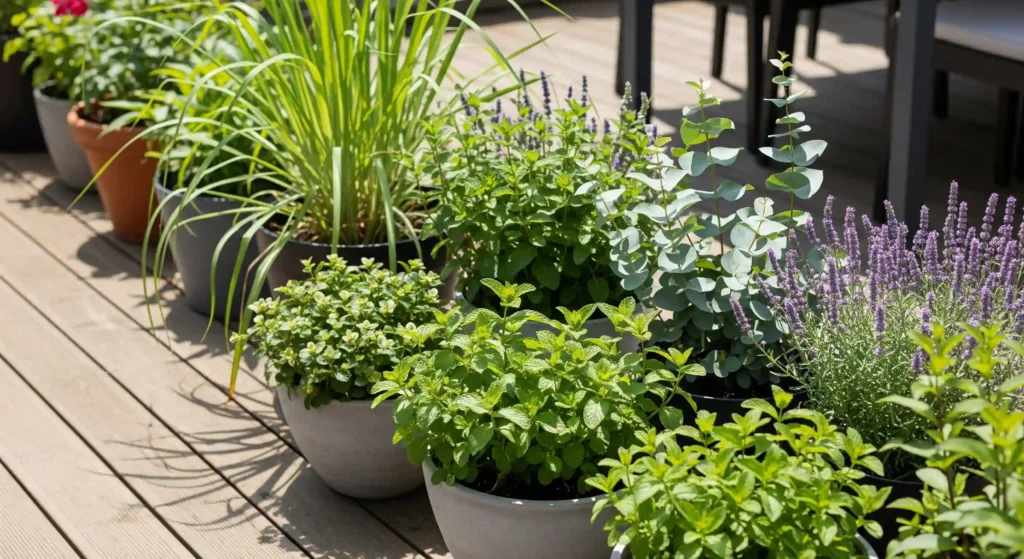
- Do this: This can be accomplished by placing multiple pots of lemongrass, eucalyptus, or peppermint directly along the edge of your patio, deck, or seating area. Grouping flowers together concentrates their repellant smells precisely where you plan to sit, forming a strong, localized barrier that will make bees less likely to approach. For a lovely and useful arrangement, think of using a mixed container with a tall eucalyptus in the middle and mint flowing over the sides.
- Not that: Don’t expect miracles from a single pot of mint on a large deck. To have an impact, you need to have enough fragrance. Additionally, avoid planting a whole in-ground garden bed full of these plants distant from your dining area because their aroma won’t be strong enough to shield it.
Additional Strategic Tips
- Think About the Wind: Observe which way the wind is blowing on your patio. Your aromatic pots should ideally be positioned upwind from your seating area. This increases the effectiveness of your barrier by allowing the breeze to naturally convey the repellent scents through your seating area.
- Keep It Clean: Keep in mind that bees are drawn to delicious objects other than flowers. Fruit that has fallen from surrounding trees, open soda cans, and spilled sugary drinks can all be strong attractants. Maintaining a clean bee-free zone can greatly facilitate the work of your repellent plants.
- Avoid Mixed Messages: A pot of lavender, which attracts bees, should not be placed next to a pot of mint, which repels bees. This can counteract the impact of your deterrent plants and send out conflicting signals. Grouping your repellant plants together will help you build a strong “scent fence.”
- Flexibility is Key: The versatility of container gardening is one of its best features. The pots may be moved to suit your needs; for example, you can place them next to a doorway to keep bees from entering your home or group them around an outdoor dining table when you have guests. With this method, you may coexist peacefully and have a lovely, varied garden with bee-friendly flowers like lavender and coneflowers only a few feet away. They keep the rest of the yard while you keep your buzz-free area. It’s the ideal balance.
A Holistic Approach to Bee-Resistant Patio Design
Although plants are your first line of defense, considering your patio space as a whole will greatly improve your chances of success. You may reinforce the message your plants are delivering by making a few extra smart decisions that will make the region less appealing to a foraging bee.
A Flash of Red
As we mentioned earlier, bees are unable to perceive red. It appears to them as a dull, dark gray or black. This is a great design trick that you may take use of. Think of painting your pots a vivid crimson, getting a striking red outdoor carpeting, or even utilizing bright red cushions for your patio furniture. The bees will notice a less enticing, gloomy area that they are more likely to ignore while you are enjoying a bright splash of color.
Pay Attention to Your Mulch
Some ground-nesting solitary bees may find a bare piece of moist soil to be an enticing location. The ground around your patio may become less conducive to nesting if you cover it with an inorganic mulch layer, such as ornamental stone or gravel. Since many insects, including bees, dislike the lovely, aromatic scent of cedar’s natural oils, cedar mulch is another great option.
Rethink Your Water Features
Bees require a water source, particularly during warmer weather. You’ve also made the ideal bee drinking fountain if your birdbath has sloping, shallow sides. Make sure bees cannot easily access any water features close to your patio if you want to minimize bee traffic. As an alternative, fill a shallow dish with marbles or pebbles and add water to create a special “bee bath” remote from your seating area. This keeps them out of your personal space while providing a safe drinking area.
Location, Location, Location
Consider your yard from the viewpoint of a bee. Is your patio right between a lovely bed of lavender flowers and a clump of bee-friendly clover in the lawn? If so, your dining location is right in the middle of a big bee’s flight path. If at all feasible, place your main areas of leisure away from these “bee superhighways.”
A Handbook for Peaceful Coexistence
Let’s face it, no approach is infallible. Even if your patio is the most fragrant on the street, an inquisitive bee can still stop by to have a look. Avoiding panic is crucial in these situations. The last, most important stage in establishing a tranquil environment is to comprehend the bee’s objectives and respond appropriately.

Know Your Visitor
Being aware of who you are interacting with is beneficial.
- Usually fuzzy and golden-brown, honeybees concentrate on just one bloom at a time.
- Bumblebees are large, fluffy, and resemble cartoons. They saunter in the air.
- Generally speaking, both are quite submissive and uninterested in you; they are solely concerned with their jobs. In contrast, a wasp or hornet is usually sleek, thin, and has more distinct black and yellow markings. It also tends to move more erratically and jerkily. These insects can be more hostile and are most likely to be interested in the food you brought for your picnic.
The Art of Doing Nothing
Just let a honeybee or bumblebee alone if it is buzzing around a plant. It’ll be over soon enough. It is probably just curious or confused if it approaches you. Avoid swatting at it. The most frequent cause of stings is a swat, which is a universal indicator of aggressiveness. The bee will protect itself since it will consider it a threat to its life.
The Gentle Nudge
Remain composed if a bee lands on you, your table, or your beverage. It may frequently be encouraged to move forward without feeling frightened by a very mild blow of air. Another option is to gently encourage it to tread on a piece of paper, then let it go a few feet away. The secret is to proceed slowly and deliberately.
In the Event of a Sting
First aid is straightforward in the rare event that a sting occurs, which typically happens when you walk on a bee or trap it against your skin. Scrape the stinger off with your fingernail or a credit card. Avoid using tweezers to pinch it as this could inject additional venom. To lessen swelling, wash the area with soap and water and apply a cold compress. Antihistamines sold over-the-counter can relieve itching. Naturally, you should get medical help right once if you know you have a serious allergy.
Dispelling Myths: Plants Often Assumed to Keep Bees Away
There is a lot of garden advice on the internet, but regrettably, some of it is based more on folklore than on fact. Let’s dispel some popular misconceptions regarding plants that people believe repel bees but are actually unreliable options to save you time and effort.
- The Marigold Debate: This is most likely the most confusing issue. Some marigold species, especially French marigolds, are known to repel some soil worms and garden pests due to their strong fragrance. It’s common to extrapolate this finding to all flying insects. Their impact on bees is hotly contested, though. I know this because I have had many hoverflies and smaller native bees visit my marigold beds. They are not a bee’s favorite flower, but they are also not a good repellent.
- Geraniums (Pelargoniums): Another typical annual that frequently appears on these lists is the geranium. The rationale is frequently related to the fact that red is not a color that bees see well. Although they aren’t a bee’s main prey, they also don’t actively chase them away. A geranium won’t do much to get a bee to go if it’s nearby. The moderate perfume of scented geraniums, such as the previously stated “citronella plant,” is not as strong as that of actual citronella grass.
- Cucumbers: This is a rather perplexing myth about cucumbers that somehow endures. Cucumber peels’ acidic content is said to discourage bees. Actually, in order for cucumber plants to produce any cucumbers at all, their large, yellow, nectar-rich blossoms must be pollinated, frequently by bees! Cucumber vines will probably have the reverse impact of what you want if you plant them next to your patio.
- Carnivorous Plants: It makes sense that a plant that consumes insects would turn them off, yet bees don’t feel this way. Pitcher plants and Venus flytraps are examples of plants that have developed to draw insects with their colorful and tasty nectar. They are more likely to draw bees to the area than to drive them away, however they can occasionally catch an unwary one.
Conclusion: A Well-Rounded Strategy for Creating a Tranquil Garden
That’s it. You don’t have to declare war on our essential pollinators to create a cozy, buzz-free patio. Working smarter, not harder, is the goal. All it takes is a little bit of planned, ingenious planting to gently steer bees away from the places where we want a little quiet.
You may successfully create the ideal aromatic fence by knowing which plants repel bees, with a particular emphasis on plants with strong, overpowering fragrances like peppermint, wormwood, and eucalyptus, and utilizing them carefully in pots. This lets you make the most of your outside area while keeping the remainder of your garden a lively, inviting place for the bees to carry out their vital tasks. It is, in fact, the ideal method for bringing everyone into harmony, health, and happiness. Have fun gardening!



